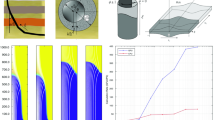Abstract
In this research, the authors developed the idealized explicit finite element method (IEFEM) to achieve shorter computing time and lower memory consumption in analyses of welding deformation and residual stress. IEFEM was parallelized by a graphics processing unit (GPU) to achieve even faster computation. To show its applicability to large-scale problems, the proposed method was applied to the analysis of the multi-pass welding of V-groove pipe joint that has 1 million elements, 13 layers, and 33 passes. In the analysis, isotropic hardening, kinematic hardening, and combined hardening were considered to investigate the influence of hardening rule on residual stress distribution. As a result, it is found that residual stress distributions were larger in the order of isotropic hardening, combined hardening, and kinematic hardening. In addition, the analyzed residual stress and experimental measurements showed good agreement. The computing time was approximately 70 h. From these results, it was shown that IEFEM can analyze a large-scale welding residual stress problem in realistic time with high accuracy.










Similar content being viewed by others
References
Hoar TP, Hines JG (1956) Stress corrosion cracking and hydrogen embrittlement. In: Robertson WD (ed) John Wiley & Sons, New York, p 107
Staehle RW (1977) Stress corrosion cracking and hydrogen embrittlement of iron base alloys. In: Staehle RW et al. (ed) NACE, Houston, p 180
Irwin GR (1957) Analysis of stresses and strains near the end of a crack traversing a plate. Trans ASME J Appl Mech 24:361–364
Sneddon IN (1946) The distribution of stress in the neighbourhood of a crack in an elastic solid. Proc Roy Soc London A-187:229–260
Ueda Y, Yamakawa T (1971) Analysis of thermal elastic-plastic stress and strain during welding by finite element method. Trans Jpn Weld Soc 2(2):186–196
Hibbit HD, Marcal PV (1973) Numerical thermomechanical model for the welding and subsequent loading of a fabricated structure. Comput Struct 3:1145–1174
Fujita Y, Nomoto T (1971) Studies on thermal elastic-plastic problems. J Soc Nav Archit Jpn 130:183–191
Shibahara M, Ikushima K, Itoh S, Masaoka K (2011) Computational method for transient welding deformation and stress for large scale structure based on dynamic explicit FEM. Q J Jpn Weld Soc 29(1):1–9
Wriggers P (2008) Nonlinear finite element methods. Springer, Berlin, pp 209–212
Ikushima K, Shibahara M (2014) Prediction of residual stresses in multi-pass welded joint using idealized explicit FEM accelerated by a GPU. Comput Mater Sci 93:62–67
Harada T, Koshizuka S, Kawaguchi Y (2007) Smoothed particle hydrodynamics on GPUs. Proceedings of computer graphics international, pp 63–70
Japan nuclear energy safety organization: evaluation of Ni-based alloy PWSCC integrity evaluation method 2010 fiscal year progress report, 2012
Maekawa A, Kawahara A, Serizawa H, Murakawa H (2014) Fast three-dimensional multipass welding simulation using an iterative substructure method. J Mater Process Technol 215:30–41
Leggatt RH, Smith DJ, Smith SD, Faure F (1996) Development and experimental validation of the deep hole method for residual stress measurement. J Strain Anal Eng Des 31(3):177–186
Mahmoudi AH, Hossain S, Truman CE, Smith DJ, Pavier MJ (2009) A new procedure to measure near yield residual stresses using the deep hole drilling technique. Exp Mech 49:595–604
Author information
Authors and Affiliations
Corresponding author
Additional information
Doc. IIW-2546, recommended for publication by Commission X “Structural Performances of Welded Joints—Fracture Avoidance.”
Rights and permissions
About this article
Cite this article
Ikushima, K., Itoh, S. & Shibahara, M. Development of idealized explicit FEM using GPU parallelization and its application to large-scale analysis of residual stress of multi-pass welded pipe joint. Weld World 59, 589–595 (2015). https://doi.org/10.1007/s40194-015-0235-2
Received:
Accepted:
Published:
Issue Date:
DOI: https://doi.org/10.1007/s40194-015-0235-2




